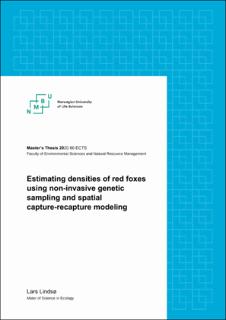| dc.contributor.advisor | Bischof, Richard | |
| dc.contributor.advisor | Dupont, Pierre | |
| dc.contributor.advisor | Eide, Nina E. | |
| dc.contributor.advisor | Flagstad, Øystein | |
| dc.contributor.advisor | Rød-Eriksen, Lars | |
| dc.contributor.author | Lindsø, Lars Kristian | |
| dc.date.accessioned | 2021-02-24T17:41:17Z | |
| dc.date.available | 2021-02-24T17:41:17Z | |
| dc.date.issued | 2020 | |
| dc.identifier.uri | https://hdl.handle.net/11250/2730217 | |
| dc.description.abstract | Spatial capture-recapture modelling (SCR) is a powerful tool for estimating densities, population size and space use of elusive animals. However, SCR modeling has not been widely applied to ecologically important mesopredators like the red fox. Here I apply SCR modeling in combination with non-invasive genetic sampling (NGS) to estimate red fox (Vulpes vulpes) densities in two 225 km2 areas of boreal forest in Lierne municipality in central Norway (2016-2018) and in the Skrim in southern Norway (2017-2018). DNA from scats, urine and hair was extracted, amplified and genotyped using 13 microsatellite markers. Of 785 samples collected, 378 (48 %) were successfully genotyped and given individual IDs. From these, 60 unique individuals were identified in Lierne and 38 in Skrim. I compared 16 candidate SCR models including spatial covariates on density and detection using AIC.
Estimated densities in Lierne were 0.04 foxes per km2 (95%CI 0.02-0.09) in 2016, 0.09 (95%CI 0.05-0.18) in 2017 and 0.07 (95%CI 0.04-0.13) in 2018. In addition, density was predicted by a forest cover habitat covariate where density increased exponentially with forest cover (beta = 2.83; 95%CI 0.02-5.63). Estimated home range size in Lierne was for 45 km2 (95%CI 34 - 60) for females and 88 km2 (95%CI 69 – 113) for males. In Skrim, the top model did not include a habitat covariate on density. Estimated densities were 0.16 foxes per km2 (95%CI 0.09-0.26) in 2017 and 0.10 (95%CI 0.07-0.16) in 2018. Estimated home range size in Skrim was 26 km2 (95%CI 16 - 42) for females and 56 km2 (95%CI 35 - 91) for males.
Results reported here validate SCR modeling in combination with NGS as a reliable method for monitoring red fox populations. Methods applied can be developed further to include different types of data for more precise estimates, including DNA from recoveries of dead foxes and partially identified individuals. | en_US |
| dc.language.iso | eng | en_US |
| dc.publisher | Norwegian University of Life Sciences, Ås | en_US |
| dc.rights | Attribution-NonCommercial-NoDerivatives 4.0 Internasjonal | * |
| dc.rights.uri | http://creativecommons.org/licenses/by-nc-nd/4.0/deed.no | * |
| dc.subject | red fox | en_US |
| dc.subject | rødrev | en_US |
| dc.subject | spatial capture-recapture | en_US |
| dc.subject | non-invasive genetic sampling | en_US |
| dc.subject | romlig fangst-gjenfangst | en_US |
| dc.title | Estimating densities of red foxes using non-invasive genetic sampling and spatial capture-recapture modeling | en_US |
| dc.type | Master thesis | en_US |
| dc.source.pagenumber | 36 | en_US |
| dc.description.localcode | M-ECOL | en_US |

